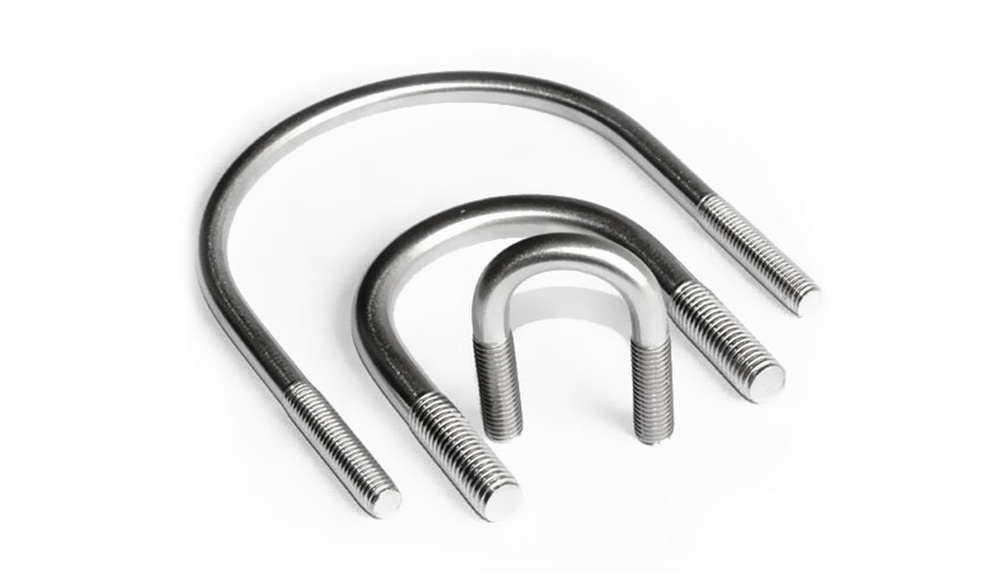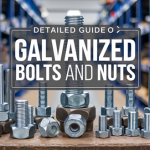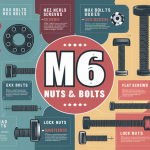Introduction:

When it comes to securing or connecting components in a project, the correct fastener can make all the difference. Among the several options available, U-bolts stand out as a multipurpose and consistent choice. Nonetheless with several types and sizes to pick from, selecting an appropriate U-bolt for your project can be a difficult task. Also, not all U-bolts are created equal. Different u Bolts come in various materials that offer different strengths and weaknesses.
What is a U-bolt?
The U-bolt plays a vital role in the performance of your needs. It features two arms extending from a central body. It safely attaches two objects, such as a pipe to a plate or a beam to a column. , U-bolts are a multipurpose fastening solution for a widespread range of apps, giving a secure and inflexible attachment. Their exclusive design makes them perfect for applications where a traditional bolt won’t serve.
Let us embark on types of U bolt and factors while selecting an appropriate U-Bolt in the post below!
Steel Stud
One of the backbones of numerous U-bolts is the stainless steel. Steel is strong enough for most everyday tasks. From securing pipes or building backyard projects to fighting gravity by holding bookcases steady or anchoring swings for local heroes. While not invulnerable to corrosion or extreme temperature extremes, steel will always prove reliable as part of DIY adventures.
Galvanized u-bolts
In wet or sunny conditions, galvanized U-bolts stand watch shielding outdoor fixtures from corrosion with their zinc coat to deflect any enemy blades that might hit. It protects them with steady strength in all elements possible from garden trellises to boat railings.
Chrome and Nickel U-bolt
A Chrome and Nickel U-bolt is a type of fastener that combines the strength and corrosion resistance of both materials. This U-bolt shape allows for secure fastening and stability in various applications. From industrial machinery security and railing supports on beaches it is higher in demand.
High-temperature U-bolts
Think fiery furnaces and frigid tundras that’s where high-temperature U-bolts excel. They can withstand extreme heat and ice giants who can tolerate cold. While Selecting an Appropriate U-Bolt that is ideal for high-heat ovens and outdoor projects in harsh conditions. It can guarantee strength regardless of temperature.
Torque U-bolt
It is even known as a “lock” or “torque-limiting” U-bolt, is made to stop over-tightening, which can lead to impairment or striping of the threads. This kind of U-bolt features a particular design that protects the torque applied to the bolt, confirming a safe and secure joining.
Adjustable U-bolt
Adjustable U-bolt is even called sliding and adjustable-socket U-bolt. They offer the suppleness to adjust the bolt’s length to adjust different sizes and shapes of objects. It is perfect for apps where the object’s sizes or outline may differ, such as in buildings, manufacturing, or repairs.
Zinc-Plated U-Bolts
These zinc u bolts offer better-quality erosion resistance due to the zinc covering. This makes them the best choice for indoor environments providing a balance among cost and durability.
Read Also: U Bolt Mastery: Grades, Applications, and Selection
Important Factors to Choose the Appropriate U-bolt:
There are numerous key elements to look for when choosing the proper U-bolt. First, materials have to be exposed to environmental conditions, such as chrome steel, to save you from corrosion. The length and shape have to be appropriate for the software program, and at the same time, the first-class of the cable ensures compatibility.
1. Material:
Pick a U-bolt made from a material that suits the application:
– Stainless steel (deterioration tough)
– Carbon steel (higher strength)
– Alloy steel (powerful and struggle to rust)
2. Size:
Select a U-bolt with the appropriate dimensions:
– Thread diameter and pitch
– Length and width
– Inside diameter (ID) and outside diameter (OD)
3. Thread type:
Determine the thread type:
– UNC (Unified National Coarse)
– UNF (Unified National Fine)
– Metric threads
4. Finish:
Consider the surface finish:
– Plain (unfinished)
– Zinc-plated (weathering resilient)
– Chrome-plated (corrosion-resistant and decorative)
5. Strength and load capacity:
Choose a U-bolt that can handle the intended load:
– Tensile strength
– Yield strength
– Working load limit (WLL)
6. Application:
Consider the environment and usage:
– Temperature range
– Exposure to chemicals or moisture
– Vibration or shock loads
7. Certifications and criteria:
Ensure agreement with appropriate standards:
– ASTM (American Society for Test and Materials)
– SAE (Culture of Automotive Engineers)
– ISO (International Organization for Standardization)
By knowing the above factors, you can go ahead in selecting an Appropriate U-Bolt that sees your specific needs. Make certain you have a safer and more reliable connection.
Conclusion
By knowing the diverse types of U-bolts available, you can make an informed decision when choosing the right one for your project, confirming a safe, protected, and operative connection. Some stainless steel u bolt manufacturers make products made of high-quality choose wisely from their extensive list.
FAQs:
1. What are U-bolt’s materials?
Look for marks or stamps to determine its substance! Galvanized steel has “G,” stainless steel has “SS,” and others may have abbreviated codes or letters. If unsure, ask a hardware shop staff.
2. Is there one U-bolt material for everything?
No! Steel is good for everyday use, galvanized for weather resistance, and stainless for extreme environments. The specialty materials for heat resistance or electrical conductivity.
3. Are copper and brass finishes decorative?
Not exactly! Copper conducts electricity effectively, while brass may withstand corrosion in certain situations. When choosing coating material for your project, these specialist materials may add flair and distinctive capabilities!
4. Can my U-bolt handle extreme vibrations?
No worries if my U-bolt must withstand extreme vibrations. Choose U-bolts with nylon insert lock nuts for peace of mind. It prevents loosening with strong vibrations, keeping your project solid.
5. Does it conduct electricity?
Copper or brass U-bolts are useful in electrical work. For ideal electrical projects, their excellent conductivity ensures smooth current flow.
6. Where can I learn about U-bolt materials?
Online resources, manufacturer websites, hardware shop manuals, and DIY blogs provide U-bolt material information. Try your local hardware shop for fastener magic specialists!
7. Should I worry about U-bolt rust?
It depends! In outdoor or damp situations, use galvanized or stainless steel, contact an expert, or use corrosion-resistant material.
8. Can U-bolts be painted or decorated? Possibly
Sure! As long as it doesn’t hinder their strength or usefulness! Use your creativity to decorate these bendy heroes with colors, designs, and patterns!
9. Why do U-bolt materials stand out?
U-bolt materials are used in so many applications, from aircraft flying through the sky to boats cutting through waves. They make you think of a superhero holding up gigantic structures!
10. Where can I get unique U-bolt ideas?
DIY blogs, Pinterest, and hardware shop websites. All provide unlimited resources for crafting great. Your imagination is the limit for U-bolt designs like garden trellises and hanging light fixtures!
Read Also:







